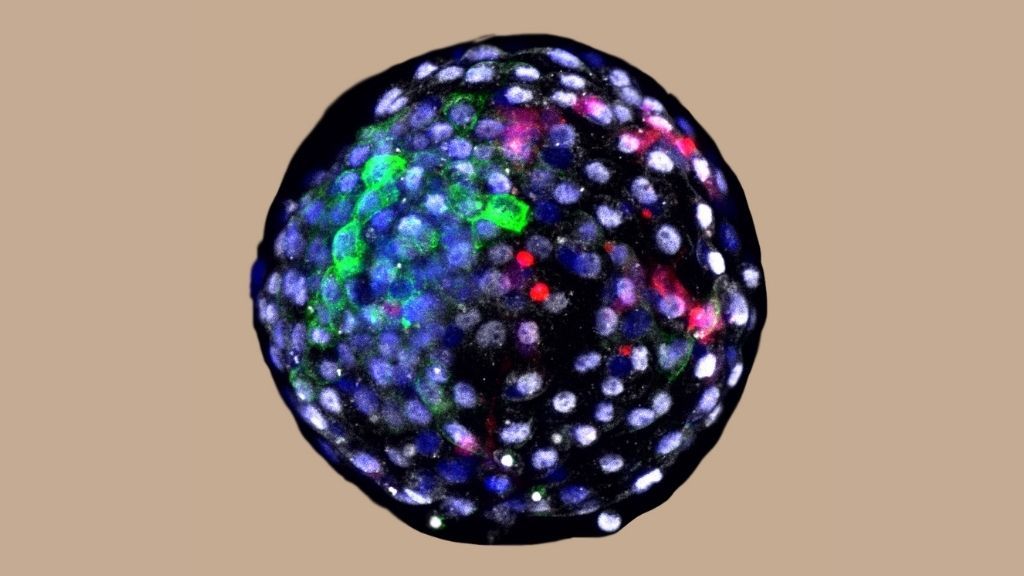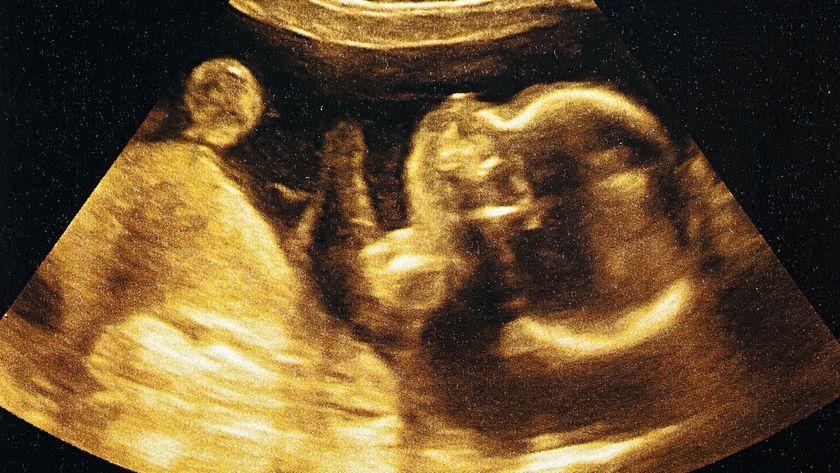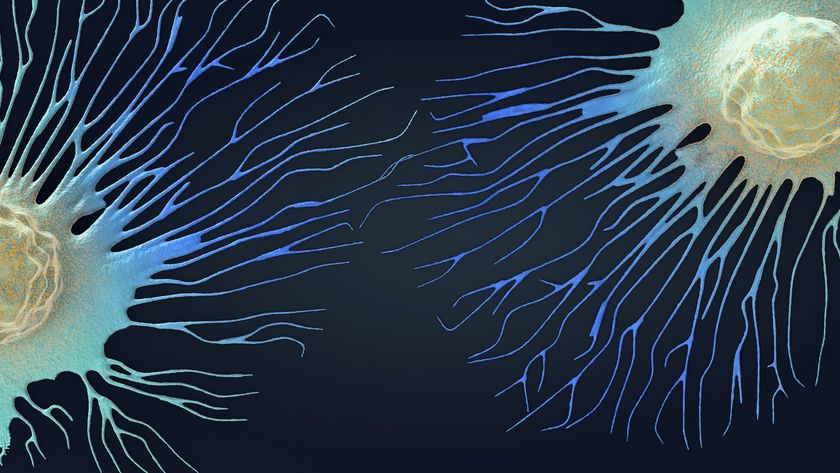Part-human, part-monkey embryos grown in lab dishes

Scientists injected dozens of human stem cells into developing monkey embryos, and the resulting hybrids survived for up to 20 days in lab dishes.
These human-monkey embryos could someday serve as helpful models for human disease, embryonic development and aging, the study authors noted in a new report, published April 15 in the journal Cell. By zooming in on the interaction of human and animal cells in the embryos, scientists could also learn how to help human cells survive amongst animal cells, potentially advancing the effort to grow human organs in living animal models.
Such studies would offer a window into human biology that would otherwise require experimenting on humans, making such studies currently impossible. Of course, the development of human-animal chimeras — organisms that contain cells from two or more species — raises its own ethical concerns, especially in regard to how long such embryos should be allowed to develop.
In the past, scientists have attempted to incorporate human stem cells into pig and sheep embryos, with the eventual goal of growing human organs in the livestock for use in transplant surgeries, Science Magazine reported. But very few human cells survived the experiments.
Related: 11 body parts grown in the lab
The low survival rate could be due to the fact that pigs and sheep aren’t closely related to humans, evolutionarily speaking, senior author Juan Carlos Izpisúa Belmonte, a professor at the Salk Institute for Biological Studies in La Jolla, California, told Live Science in an email. For instance, pigs and humans have been diverging from each other for 90 million years, when they last shared a common ancestor, he said.
Because the researchers used monkeys in the new study, "the evolutionary distance is smaller, and this may account for the greater relative efficiency of integration of human stem cells in the chimera," he told Live Science. New data gathered from the human-monkey embryos could provide hints about how to better grow human cells in more distantly related animals, Izpisúa Belmonte said.
Sign up for the Live Science daily newsletter now
Get the world’s most fascinating discoveries delivered straight to your inbox.
While this line of research could lead to exciting advancements in medical science, there are ethical concerns to address, said Alejandro De Los Angeles, a stem cell biologist at the Yale University School of Medicine, who was not involved in the study.
"One of the main concerns with human-animal chimeras is whether 'humanization' of the chimeras will occur, for example, whether such chimeras acquire human-like cognition," De Los Angeles told Live Science in an email. However, these concerns don't necessarily apply to the new experiment, given that the embryos were only allowed to develop for a limited time and weren't implanted in a uterus, he said. But for future studies, "it will be important to discuss how long experiments should be allowed to go for," he said.
Mixing monkey and human cells
To produce the human-monkey embryos, the researchers first collected oocytes — a precursor to mature egg cells — from Cynomolgus macaques (Macaca fascicularis), matured the cells in culture and then injected them with macaque sperm to fertilize them. After six days, the fertilized cells divided into additional cells and then assembled into hollow spheres, known as blastocysts; in a normal pregnancy, a blastocyst would implant in the uterus and later give rise to a full-fledged embryo.
In this experiment, the team transferred the developing monkey blastocysts into lab dishes and used a laser to remove their transparent outer coating, called the zona pellucida. Without an intact zona pellucida, blastocysts attach to the lab dish they're placed in, somewhat mimicking how they'd implant in the uterine wall. The team then applied a technique developed by study co-author Weizhi Ji and his lab that enables monkey embryos to survive for 20 days outside the maternal body; this technique involves making minute adjustments to the culture solution surrounding the cells.
Even so, the conditions don't perfectly replicate that found in a living organism, Izpisúa Belmonte said. "This will ... have an effect not only on the development of the monkey embryos but on the donor human cells as well," he said.
"Despite these considerations, it is really surprising that many embryos developed for an extended period of time," Izpisúa Belmonte added.
Six days after fertilizing the monkey cells, the researchers injected 25 human stem cells into each blastocyst. These cells, called extended pluripotent stem (EPS) cells, can differentiate into both embryonic tissue and "extraembryonic" tissues, which support the developing embryo by supplying nutrition and removing waste.
All 132 embryos still contained human cells one day after implantation, but only 111 embryos successfully attached to the lab dishes. Of these, 103 embryos survived to day 10 after fertilization. Their numbers fell steeply between days 15 and 19, leaving only three surviving embryos by the end of the experiment.
More than half of the surviving embryos still contained human cells at day 9, and about one-third still contained human cells at day 13. These human cells integrated into the inner cell mass, the part of the blastocyst that gives rise to the embryo, yolk sac and amnion (a protective membrane). The number of human cells that survived far exceeded that observed in a previous study, in which Izpisúa Belmonte and his colleagues injected human cells into pig embryos.
Next steps and ethical considerations
In addition to tracking how many human stem cells survived throughout the experiment, the team also analyzed which genes switched on in the chimeric embryos during development, and which proteins they produced. The team gathered the same data from a set of unaltered monkey embryos, to see whether gene expression appeared different in the chimeric embryos.
"The authors ... observed some changes that occurred in monkey cells following the introduction of human cells into the monkey embryo," De Los Angeles told Live Science. "There was some cross-talk between the human and monkey cells."
Compared with the unaltered embryos, the chimeric embryos switched on additional genes and built up a different suite of proteins, the authors found. They hypothesize that some of these genes and proteins may be involved in "communication" between the monkey and human cells, and that these lines of communication may be key to the human cells' prolonged survival, Izpisúa Belmonte said.
Looking forward, the team plans to study these communication pathways further "to determine which ones are critical to the success of this process," Izpisúa Belmonte said. If these molecular changes could be replicated in other species, such as pigs, it could potentially improve attempts to grow human tissues and organs in these animals, he added.
When thinking about the future of chimeric embryos, scientific ethics must enter the discussion, Henry Greely, director of Stanford's Center for Law and the Biosciences, and Nita Farahany, director of Duke's Initiative for Science & Society, wrote in a commentary of the new study. These embryos, by their nature, raise different concerns than the direct transplantation of human cells and tissues into animals, they wrote.
With direct transplantation, researchers can predict how transplanted tissues will integrate into the larger animal and can determine whether a transplant might enter an area of concern, such as the brain and gonads, they wrote. But in a chimeric embryo, human cells can potentially become incorporated throughout the entire organism, assuming the embryo is allowed to develop for some time.
In the new experiments, "the embryos here were not transferred into a uterus, and thus could not lead to living chimeric animals or even fetuses," and growing full-fledged chimeras in a womb is not the long-term goal of this research, they noted. "Implantation of human-monkey embryos would be ethically contentious and will need to be discussed by scientists, ethicists and the public before moving forward with such experiments," De Los Angeles said.
Additionally, scientists will need to seriously consider the welfare of animals involved in future chimera research, particularly that of non-human primates, and also gauge the potential risks and benefits to humans, Greely and Farahany wrote. The National Academies of Sciences, Engineering, and Medicine recently released a report outlining ethical considerations for the use of human brain or nerve tissue in chimeras, but there's been little discussion surrounding chimeric embryos more broadly, they noted.
Now that it may be possible to grow human-primate embryos for extended periods of time, these discussions should happen sooner rather than later, they said.
Originally published on Live Science.

Nicoletta Lanese is the health channel editor at Live Science and was previously a news editor and staff writer at the site. She holds a graduate certificate in science communication from UC Santa Cruz and degrees in neuroscience and dance from the University of Florida. Her work has appeared in The Scientist, Science News, the Mercury News, Mongabay and Stanford Medicine Magazine, among other outlets. Based in NYC, she also remains heavily involved in dance and performs in local choreographers' work.











